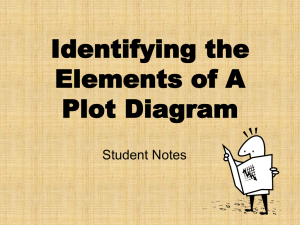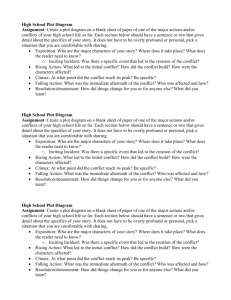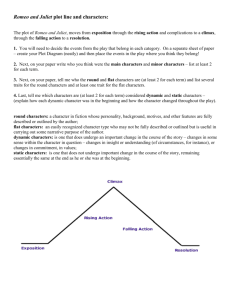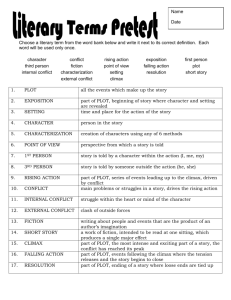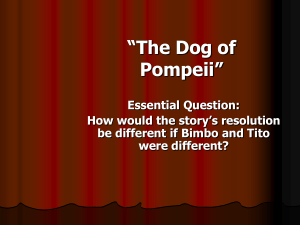The Play
advertisement
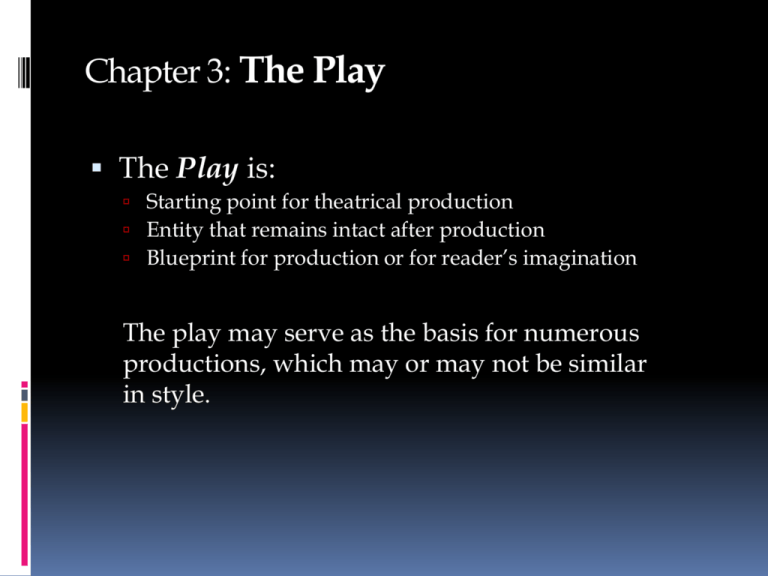
Chapter 3: The Play The Play is: Starting point for theatrical production Entity that remains intact after production Blueprint for production or for reader’s imagination The play may serve as the basis for numerous productions, which may or may not be similar in style. The Play While the Play and the Production are connected closely, they are separate entities. Plays: • considered Dramatic Literature • often taught separately from Theatre • most fully experienced during Production On Reading a Play How does reading a play differ from reading other types of literature? Requires reader to envision the action Requires reader to synthesize information from a variety of sources, including: • Stage Directions • Dialogue • Character Interaction • What is Unspoken Dramatic Action According to Aristotle Play = a representation of human beings in action Action = what characters do and why they do it According to Francis Fergusson Dramatic Action builds through 3 steps: 1. Purpose: awareness of desire or goal 2. Passion: strength of desire or passion to fulfill goal 3. Perception: understanding that comes from struggle Dramatic Action Characteristics of Effective Dramatic Action Complete and Self-Contained: beginning, middle, end Deliberate Shape or Organization that reveals Purpose Variety Engages and Maintains Interest Internal Consistency Methods of Organizing Dramatic Action A play is composed of incidents organized to accomplish a purpose. Methods of Organizing Dramatic Action Most Common Sources of Unity: Cause-to-Effect: logical progression of actions/events Character: all events focus on one character Thought: scenes linked by central theme or idea Other Sources of Unity: Dominant Mood Visual Style Distinctive Use of Language Methods of Organizing Dramatic Action The 6 Parts of Drama, defined by Aristotle: Plot Character Thought Diction Music Spectacle Plot Summary of a play’s incidents Organization of all elements into a meaningful pattern Overall structure of play Two Most Common Plot Structures: Episodic: jumps from scene to scene, early point of attack, treats character or concern, creates a broad perspective Climactic: cause-to-effect action, late point of attack, creates sense of compression or dramatic tension Plot The Beginning Establishes: place, occasion, characters, mood, theme, internal logic Exposition The setting forth of information about earlier events, identity, relationships, etc. Point of Attack The moment at which the story is taken up Earlier point of attack = need less exposition Later point of attack = need more exposition Plot The Beginning Inciting Incident An occurrence that sets the main action in motion and leads to: Major Dramatic Question A central question that drives the action forward Example: “What will the character do now?” Question may change as action progresses Plot The Beginning Exposition The amount of exposition is determined by the relationship between the Point of Attack and the Inciting Incident Exposition Early Point of Attack Exposition Rising Action Rising Action Inciting Incident Inciting Incident Late Point of Attack Plot The Middle Complication Any new element that changes the direction of the action Series of Complications = Rising Action Discovery Any new information of sufficient importance to alter the direction of action Substance of most Complications Plot The Middle Climax Rising Action culminates in Climax Highest point of interest or suspense Climax often accompanied or preceded by Crisis Crisis Discovery or event that leads to the climax and determines the outcome of the action Plot The End Resolution or Denouement Unraveling or untying The dramatic question has been resolved Other Attributes of Plot Subplots Events or actions of secondary interest Plot Climactic Plot Structure Exposition Climax Rising Action Complications Point of Attack Inciting Incident Denouement Character Characterization Anything that delineates a person or differentiates that person from others Four Levels of Characterization 1. Physical or Biological: gender, age, size, race, appearance 2. Societal: economic status, religion, relationships 3. Psychological: habitual responses, desires, motivations 4. Moral: morals as reflected by choices and decisions Character How is Character Revealed? 1. Through Stage Directions, Prefaces, Other Materials 2. Through what the Character Says 3. Through what Others Say about the Character 4. Through what the Character Does Something to Think About: Imagine that you are playing the role of Yourself. How is your character revealed by the 4 elements listed above? Thought Thought includes: Themes, arguments, overall meaning of the action Meaning is suggested by: • Relationships among characters • Ideas associated with unsympathetic and sympathetic characters • Conflicts and their resolution • Devices such as spectacle, music, song Meaning in drama is usually implied rather than stated directly. Thought Although a play implies or states Meaning, this does not mean that there is a single correct interpretation for the play. Most plays permit multiple interpretations. Each interpretation should be supported by evidence within the script. Sound and Spectacle To convey Plot, Character, and Thought playwrights have at their disposal two means: Sound All aural element of a production Spectacle All visual elements of a production Sound Diction = Language The playwright’s primary tool for communication Purposes of Diction: • • • • • • • to impart information to characterize to direct attention to important plot elements to reveal themes and ideas of the play to establish tone or mood to establish internal logic to establish tempo and rhythm Sound How is effective diction judged? Appropriateness to: • Characters • Situation • Internal Logic • Type of Play Sound Music (as used here) = all patterned sound Includes the Sounds of the Actors’ Voices: • Pitch • Stress • Volume • Tempo • Duration • Quality Sound Music (as used here) = all patterned sound Includes Music: • Incidental songs • Background music • Integrated song • Integrated instrumental accompaniment Sound Purposes of Music: • to establish mood • to characterize • to suggest ideas • to compress characterization • to compress exposition • to lend variety • to add pleasure Spectacle Spectacle = all visual elements of production Includes: • • • • • • • Movement of characters Spatial Relationships of characters Lighting Settings Costumes Properties Special Effects Form in Drama Form = the shape given to something for a particular purpose Some Forms of Drama: • • • • • Tragedy Comedy Tragicomedy Melodrama Farce The 2 most basic forms • Tragedy • Comedy Plays are classified into Forms based on: • types of action • overall tone • basic emotional appeals Tragedy Oldest form of Drama Presents genuinely serious action Maintains serious tone May contain moments of comic relief Tragedy Raises significant issues about: • • • Human existence Morality Human relationships Protagonist (leading character) arouses audience’s sympathy or admiration but encounters disaster in pursuit of goal Associated especially with: • • Ancient Greece Elizabethan England Comedy • Origins in Ancient Greece • Based on a deviation from normality in action, character, or thought • Maintains tone of “in fun” • Requires audience to view situation and events objectively • Any subject can be the topic of a Comedy if the audience can distance itself sufficiently from serious implications of the action Other Forms Tragicomedy • A serious play that ends happily Farce • A light dramatic work in which highly improbable plot situations, exaggerated characters, and often slapstick elements are used for humorous effect Other Forms Melodrama • • • • • • A mixed form Develops a temporarily serious action that is initiated by villain Depicts world with clear differentiation of good and evil Audience desires to see good win over evil Destroying the villain’s power results in happy resolution Most popular form of Theatre in the 19th century Concern for giving formal labels to Plays has diminished considerably, as many contemporary plays mix formal elements and characteristics. Style in Drama Style Results from a distinctive mode of expression or method of presentation May stem from traits connected with: • Period • Nation • Esthetic Movement • Author Style in Theatre Style Results from 3 Basic Influences: • Assumptions about Truth and Value • Manner of Expression • Production Style Making Connections: Part I presents some basic issues of theatre, including: its nature and function; its relationship to other forms of art; criteria for judging theatrical performances; and how plays are structured Consider the materials covered so far as you address the following questions: 1. Why do people create Theatre? 2. What attracts audiences to Theatre performances? 3. What makes one production seem better to us than another?



